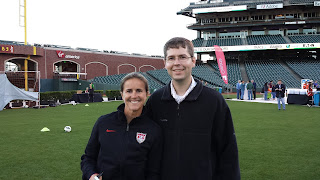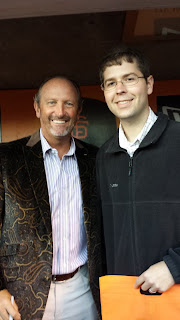So in my last post I summarized a lot of the high points of my VMWorld experience even though I didn't make it through every day. Rather than type up a summary of the rest of the days I thought it might be a bit more beneficial to talk about lessons that I learned from my first VMWorld experience for first timers that may be looking at this next year or in future years. I know that in my preparation I was reviewing tips and lists from a number of notable bloggers and industry folks out there to figure out how to best get ready for the conference and I highly suggest you read those as well to get varying opinions. Without further ado:
1. Wear comfortable clothes - This one was easier for me than I think it may be for other folks who are trying to network to find a new job or opportunity but I wanted to make sure I was comfortable this week. My standard work attire consists of a comfy pair of sneakers, jeans that aren't torn to shreds, and a polo or button up shirt and this is what I wore throughout the entire conference. Comfortable is relative to the person wearing the clothes so this can be whatever you want it to be. I saw people wearing t-shirts and jeans, I saw people in suits, and just about everything in between so odds are you'll be fine with whatever you decide to wear.
2. The food at VMWorld isn't awful - Don't get me wrong, it's not GREAT either but it's certainly edible. I did my best to try to eat Breakfast/Lunch most days at the conference to try to keep my expenses down and most days there were decent options. There are much better options out there so if you have the budget or just don't want to eat the VMWorld food you can do so, but most everything I read prior to the trip was bashing the food so I wanted to ensure I provided my opinion on this one. Plus the meals are a great time to strike up a conversation with other IT pros and chat about the conference or swap IT stories. I had some successes and failures with this myself but I'm glad I made the effort.
3. You can't go to every breakout session even though you might really want to - I booked 5-6 sessions every day that I was interested in going to see and I probably bailed on 1 or 2 daily because there simply wasn't enough time. You'll find very quickly that there is so much to do and see that something is going to come up and you'll likely end up missing a session or two if you book too many. For me, I usually missed a session because I was on the floor of the solutions exchange talking with a customer of a product I was interested in or because I was just super tired and needed to take a break. The good thing is that if you bail on the session that opens up a spot for someone in the standby line who wants to see the session so it balances itself out, but try to schedule the sessions that you really want to see and remember that you can always watch the recordings of the sessions after they are posted online. Which leads me to the next item..
4. Don't take a picture of every slide in the breakout sessions - I seriously could not figure out why people were doing this. The sessions get posted online after the conference and all attendees have access to these recordings, but still I saw phones and tablets going up after every slide change. All I could do was shake my head. Don't be that guy/gal.
5. Take breaks - The days will go by quickly but it's best to remember to stop and take a break every now and then so you don't wear yourself out. This could be stopping by the hang space for a bit, or just arriving at a session a bit earlier than you planned and taking a rest. Going along with this I carried Water/Snacks with me at all times in my VMWorld backpack and that was extremely helpful. It can get a bit hot in the solutions exchange especially with all of those people in there so it helps to have the water nearby. There's also plenty of water dispensers set up if you don't want to carry it around all the time.
6. Use social media - One of the things I enjoyed most during the conference was following along on Twitter with what the big names had to say, but also what people thought of the sessions that I was in. Every session has a session ID which makes for an easy hash tag and I did my best to use these to comment on every session that I was in. Some sessions had a lot of activity on Twitter this way, and others did not which was somewhat disappointing after experiencing some of the more socially active ones. I was also checking badges for twitter handles and I was sad that I didn't see very many amongst the general attendees. Perhaps they weren't on twitter or they just didn't want to share and that's fine either way, but I was hoping to find some more folks to follow outside of the big names and I didn't get a whole lot of them.
Side note from this one: Eric Shanks did a great statistical look at Twitter usage from this year's VMWorld here.
7. Engage the presenters or other big names - I'll admit I didn't do as good a job with this one as I would have liked, but I did better than I expected. Most of the folks are very approachable and will talk to you or just say Hi if that's all you're looking for. One of the people I had a chance to meet and speak with was Simon Long and he was very nice to talk to. His blog was a great resource when I was starting out in virtualization and prepping to take my first VCP exam (Version 4) and I wanted to thank him for putting all of that together. I also ran into Scott Lowe on my way out on the last day and I just said Hi to him and he was very nice and offered me an extra Spousetivities t-shirt for my wife which was awesome. This is one I hope to improve on next year.
8. Have extra room in your luggage - Airline bag fees suck and the last thing you want to do is have to check an extra bag on the way home. You are going to come home with more stuff than you showed up with unless you just completely avoid the solutions exchange which I do not recommend. I ended up coming home with like 17 or 18 new shirts, some bags, plus all the little trinkets like buttons and stickers and such that vendors like to give out. I brought a larger suitcase than I normally travel with for this specific reason and I am VERY glad that I did. I was able to get the extra backpack and all this stuff into my bag which just made it easier to deal with when I was going home (although the bag was quite a bit heavier I do admit). Most airlines allow two carry-ons and if they run out of room in the overheads they'll check it for you for free so that's another good way to handle it if you prefer.
9. Let your vendors know you're going to VMWorld - Most of them are throwing parties or putting on events during the nights of the conference and they will usually extend you an invite if they know you're going. I was fortunate enough to attend the Netapp MVP event which also took place at AT&T Park the night before the VMWorld party but I didn't get an invite until a few days before the conference because my rep didn't know I was going till the last minute. Netapp put on a pretty awesome party and I got to meet some sports icons including Brandi Chastain, Joe Morgan, and Bret Saberhagen:
So let your reps know you'll be there and you never know what you might get to check out! Vendors on the solutions exchange sometimes can get you invites to their events if you stop by and ask them about it as well but I was already booked up before I even arrived.
10. Enjoy it! - It is a professional event and I was primarily there to learn and grow as an IT pro, but it's a heck of a lot of fun too. Take some time to "smell the roses" per say and take it all in and enjoy it. It really is a blast!
Hope this helps some folks that will be heading out to their first VMWorld in future years. If you remember nothing else from what I wrote here do remember #10 - enjoy the experience! I know I did and I'm already counting down to VMWorld 2014. Just 360ish or so days to go!
































